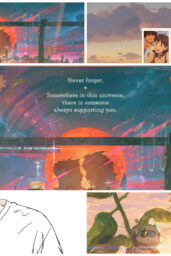“Sirât” Is a Spiritual Rave Into Oblivion — and Oliver Laxe Lights the Fuse
Nothing in the first three days at Cannes 2025 prepared audiences for Sirat. Not the polite procedural of Dossier 137, nor the well-intentioned Soviet dirge of Two Prosecutors. Then came Oliver Laxe. And the room changed.
Sirât didn’t just screen. It detonated.
Set in a Moroccan desert rave that feels more like an open-air apocalypse than a Coachella offshoot, Laxe’s film pulls you into a sandstorm of chaos, loss, and collapse. There’s sunburnt skin, screeching speakers, and somewhere, a man looking for his daughter. That man is Luis (played with aching restraint by Sergi López), whose sorrow cuts through the dust like a flare.
What begins as a dusty road movie—father, son, flyers, hope—unravels into something far more primal. And dangerous. Think: Paris, Texas spliced with Enter the Void, then fed through the warped lens of post-collapse dread.
“This isn’t just a missing-persons story. It’s a civilization-on-the-brink story masquerading as one.” — IndieWire Cannes Daily

Burn It Down and Start Again
Halfway through, Laxe breaks his own film. Not gently. Not gradually. A tragedy hits like a wrecking ball, and suddenly Sirât isn’t a movie—it’s a hallucination. A collective one. The plot evaporates. Characters dissolve. Time bends. Reality forgets itself.
The rave becomes a ruin. The search turns mythic. By the third act, we’re deep in Mad Max territory, if Antonioni wrote the script and forgot to include roads.
This is Laxe’s great subversion: he weaponizes his arthouse roots to disorient, then redeploys them as emotional artillery. If his earlier film Fire Will Come whispered, Sirât screams into the abyss. And it echoes.
Chaos With a Pulse
Cinematographer Mauro Herce deserves his own Palme d’Or. His lens is both brutal and lyrical—capturing broken bodies swaying like seaweed in dust storms, sunflared faces that look almost biblical. Every frame hums with apocalypse.
And yet, Sirât never loses its human pulse. Luis, Esteban, and the absent Mar aren’t just plot points. They’re the aching center of the film’s chaos. Lost people in a world that has stopped pretending to care. It’s all too much. And exactly enough.
Historical Echoes: The Cinema of Collapse
This isn’t the first time Cannes has been jolted by a film that rewires its genre mid-sentence. Think Lars von Trier’s Melancholia (2011), where personal grief swallowed the planet. Or Jonathan Glazer’s Under the Skin (2013), where alien detachment disguised a human scream.
But Sirât pushes the envelope further—disregarding structure altogether, letting collapse be the form and the function. Laxe joins a growing wave of directors (see: Apichatpong Weerasethakul, Bi Gan) who understand that disorientation can be its own kind of truth.
Would You Follow a Film Into Oblivion?
Laxe is betting you will. Sirât isn’t safe, neat, or even fully explainable. It’s cinema as sensation. A slow free-fall into the unknown.
Here’s the uncomfortable truth: You’ll either walk out transformed—or stagger out, wondering what just happened.
Either way, Cannes is finally awake.











